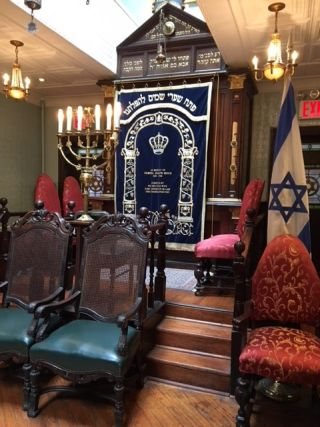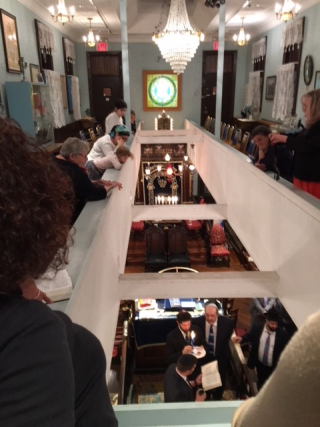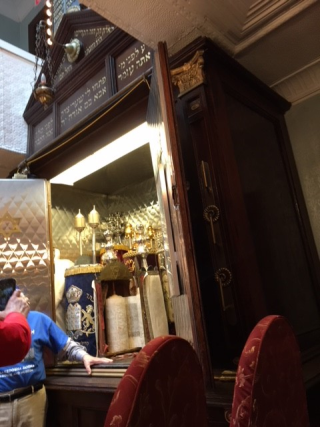Greek Jewish Festival at Kehila Kedosha Janina Synagogue,
New York City, May 5 and 6, 2018
By Judith Roumani*
A long Sabbath walk from the modern Jewish center of Manhattan took me south in geography and back in time to New York’s Lower East Side, the home a hundred years ago of numerous thriving Sephardic communities of Greece, Turkey and the Eastern Mediterranean. A poet, Stephen Levy, once enshrined the names of the streets that I passed—Eldridge Street, Allan Street, Broome Street—in his poems that also evoke the sounds of Sephardic languages that once echoed in the streets and cafes. Today, the nearby Lower East Side Tenement Museum, that imaginatively brings to life the places in which Jews from various origins perched for half a century or so before flying on to more luxurious homes on the outskirts of New York, contains one apartment that is furnished as it was when a Sephardic family (actually from Turkey) lived there.

 The life of the Romaniote Jews of Greece is not to my knowledge
evoked except in the nearby wonderful littlegem from the past, the
Kehila Kedosha Janina Synagogue. I found it in encroaching Chinatown,
far downtown on Broome Street. Pushing open the heavy door, I was
transported immediately: a synagogue exquisitely decorated, carefully
maintained, that day almost full, and a program in which five rabbis
were to speak, some on the particular culture and customs of the
Romaniote (pre-Sephardic) Jews of Greece, and others on Sephardim.
The life of the Romaniote Jews of Greece is not to my knowledge
evoked except in the nearby wonderful littlegem from the past, the
Kehila Kedosha Janina Synagogue. I found it in encroaching Chinatown,
far downtown on Broome Street. Pushing open the heavy door, I was
transported immediately: a synagogue exquisitely decorated, carefully
maintained, that day almost full, and a program in which five rabbis
were to speak, some on the particular culture and customs of the
Romaniote (pre-Sephardic) Jews of Greece, and others on Sephardim.
The new young rabbi of Athens, Rabbi Gabriel Negrin, himself of Romaniote origin, and very knowledgeable, had come in from Greece especially for the occasion, and gave a very erudite talk, illustrated with large diagrams, about the ‘Shadayot’ or amulets worn by Romaniote Jews or, traditionally, hung in their synagogues and on the curtains of the Holy Ark and on Torah scrolls, thereby sharing in the reflected holiness of the Torah. They contained blessings and prayers, and the decorative parts reflected emblems from the Sublime Port (Ottoman Empire) and Eastern Mediterranean. Following this, more American rabbis such as the rabbi from Seattle , Rabbi Ben Hassan, Rabbi Nissim Elnecave of Forest Hills, New York, Rabbi Abadie of the Upper East Side, gave talks on Sephardic culture and Halakha, and Ladino language, as well as Sephardic philosophy, as embodied in such works as the encyclopedic Me’am Lo’ez in Ladino. Seuda Shlishit (the third Sabbath meal) prayers and Havdalah for the end of the Sabbath, followed. The entire event was a unique experience, bringing together so much wisdom and enthusiasm in this small synagogue or esnoga.
The Romaniotes, this minority within a minority, succeeded in staving
off the engulfing influence of the Iberian Jews in Greece for four
hundred years. Migration to America due to war and upheavals in the
former Ottoman Empire in the early 1900s led to their building this
synagogue in 1927. Though like other Jews from their part of the
Mediterranean, they were viewed as Turks and Orientals (Turkinos as
Sephardim called themselves) by the existing well-established Sephardic
elite, they did well and eventually for the most part moved away from
the Lower East Side.
Today only one person from the community is left in the vicinity, but the traditions and building itself are proudly and lovingly maintained. The Torah scrolls include one from Yanina created in the eighteenth century, and one created in 1927 at the inauguration of the building. The “wallpaper” consists of actual silvery hand-created stencils, and an upstairs museum contains dresses, kipot, letters, books and silver Judaica from Greece. The synagogue provides descriptive leaflets and even a bibliography.
The next day, Sunday, was totally different: a street fair with music, spirited dancing, and Greek kosher food. The following bands/musical groups performed:
Stavros Theodorou Orchestra
Hellenic Dancers of New
Jersey
Noga Group with
Avram Pengas
Layla Isis
Vasilis Kostas and Friends
Trio Sefardi with
Daphna Mor
Two interviews conducted during the festival by Carlos Yebra López with a visitor to the street fair, Harry Zinn of Los Angeles, and the singer and writer Sarah Aroeste at her festival table are among the videos accessible from the Ladino 21 YouTube channel.
From shared prayers to music and food, this Greek Sephardic weekend succeeded on many levels in both enlightening and delighting.
